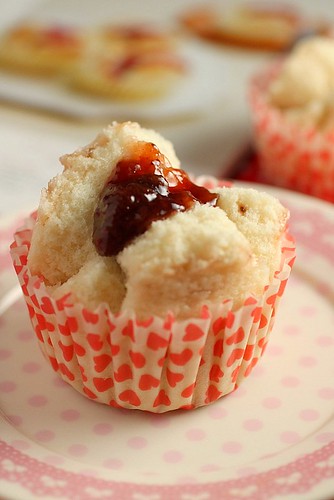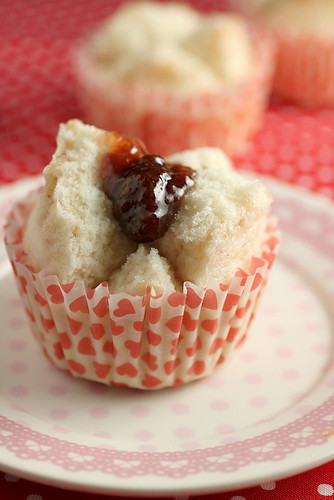
The good old steamed cake (Huat Kueh/ Fatt Ko) is gaining some serious popularity in Japan and Taiwan. The Taiwanese are crazy over the savoury version, where the cakes are steamed with pork floss, minced meat sauce and fried shallots, to name a few. The Japanese like their cakes/bread steamed with sweet potato, pumpkin, mochi, red bean etc. I picked up the popularity vibe while prowling the various cookbook sections of bookshops in Tokyo and Taipei. It is generally a good barometer to measure what is gaining following in the market. This is especially true in Japan where meticulous attention is given to specific genres of pastry/ cakes. Nowhere else in the world will you find over 10 different publications featuring only chiffon cake recipes or swiss roll recipes or donuts ... So, when you see books featuring only Fatt Ko recipes, you know the fad has landed.
I bought my first Fatt Ko recipe book early this year and tasted my first Japanese Fatt Ko in Singapore 3 weeks ago. For those who are interested, check out Mushiya at the swanky but confusing new shopping center, Ion Orchard. I was intrigued by the combination of mochi (steamed rice cake) with red bean topping on the Fatt Ko. The delightfully soft bread when eaten with pieces of chewy mochi was quite a novel and pleasant experience.... and thence my motivation to make steamed bread took off.

I knew that I had to get the basic steamed bread right - the fancy flavour and topping variations can be built in later. Having made traditional Huat Kuey before, I knew I have to pay attention to the different ingredients that are called out for in the recipe. The tradtional Huat Kuey, I feel is more symbolic than tasty. The steamed bread recipes had specified the use of a baking powder that is specially meant for steamed pastries. Apparently this kind of baking powder will result in a plump and soft steamed bread. I managed to find this recently at my favourite supermarket in Hong Kong, City Super.
Though the original recipe had called out for plain flour, I chose to use Japanese rice flour instead. The Japanese rice flour has been known to impart a more bouncy texture to cakes. Over the last few years in Japan, it has become a popular flour for chiffon and sponge rolls.
Extremely simple to whip up and the results are extremely good ! The soft, bouncy texture of the bread was exactly what I had been trying to achieve. When eaten warm, the tenderness of the bread evokes a sense of bliss and happiness.... : ) Encouraged, I believe I will start to build in the fancy toppings next.

Recipe
100 ml Milk
3 tbsp Condensed milk
Sugar 25g
Rice flour 75g (or plain flour)
Corn Starch 45g
Baking powder 1tsp ( baking powder for steaming)
Strawberry Jam 5 tbsp
Method :
1. Boil water in a pot. Line pudding molds with cup cake liners.
2. In a bowl, mix Milk, condensed milk and sugar with a hand whisk until sugar is dissolved.
3. Add dry ingredients into (1) - continue to mix until a smooth paste is obtained.
4. Spoon (3) into each cup cake liner. Fill each liner to 3/4 full.
5. Add a tbsp of strawberry jam into (4). Using a skewer, gently fold batter in each cup to cover the jam.
6. Steam over boiling water for 15 mins.
7. Cool down to warm to touch. Spoon a tsp of strawberry jam over the cake and serve with tea.


Should I try this with my apricot jam?
ReplyDeleteWe have a similar Indonesian cake called 'Kue apem', I think it's a great idea to add strawberry to the cake :)!
ReplyDeleteI'll have to try this recipe! Thanks for sharing!
ReplyDeleteShirley, I never quite like traditional huatt kuey,I will not get tempted to eat it but after seeing how you described your fatt ko, making me wondering should I try it :). BTW can we can baking powder for steaming in Spore? Thanks.
ReplyDeleteI must get a steamer. Ive been wanting to make 'kuih apam' from my aunts recipe but my steamer tumbled an dbroke (bamboo) I wonder if kuih apam and Huat kueh are actually one and the same thing? kuih apam is usually eaten with shredded coconut on top and uses yeast. Is it considered huat kueh too? Ive always been confused by these 2 cakes.
ReplyDeleteyour huat kueh looks very soft and tender The recipe looks like a keeper. cant wait for your future huat kueh variations :))
This look very much like the apam that my grandmother used for prayers. Not a fan of that but this one look really good. I don't mind having it. By the way can I just use the regular rice flour to make this?
ReplyDeleteHi Gert, I believe you can use regular rice flour. I am going to try using Top Flour (low gluten) next. I will update you once I have done that.
ReplyDeleteHi Shirley,
ReplyDeleteI'm indeed on the look out for good huat kueh recipes. I failed on my first attemps which never got to see the light on my blog. Lol..
Would this recipe work with regular baking powder?
You Fei
Love the way you "dress up" your huat goh. Very nice shots too, making the conventional all so special. ;)
ReplyDeleteThis is a simple recipe. Adding the strawberry jam is a great idea. These cakes would make very nice afternoon tea.
ReplyDeleteYou Fei, what happened to your Huat Kueh? It did not rise? I have tried making a different recipe with regular baking powder but it did not turn out as soft. This one stays soft for quite a few hours exposed at room temperature. I will experiment with normal baking powder again.
ReplyDeleteThis looks good. I've been wanting to try my hand at fatt ko for a while now. Have you tried this shop at Tanjong Pagar (further up from Pinnacle) that sells ang ku kuih. I heard that their fatt ko is good as well.
ReplyDeleteThis sounds easy. Good starter cake for a person who does not bake. :)
ReplyDeleteThey look so light and fluffy Shirley! Great idea! :D
ReplyDeleteyour Huat kueh really "Huat" and look beautiful!
ReplyDeleteFirst of all, I have an addiction to steamed bread. Especially when it's filled with red bean paste. I'm so glad you posted this! It will make my life so much easier to be able to make it at home. Gorgeous photos!
ReplyDeleteThis is not the usual huat kueh especially with strawberry jam. On my to-do list.
ReplyDeleteLove the idea of putting jam on the huat kueh. Looks nice and inviting!
ReplyDeleteI'm so gonna bookmark this! I'm trying all kinds of huat kueh coz my son loves them. Thanks for sharing! (But baking powder for steaming? I wonder if I can get it here?)
ReplyDeleteHello, your huat kueh looks special with a dollop of jam. I'm not a huat kueh person but may be I could try out with a dollop of jam, that might be different.
ReplyDeleteWow! Shirley, reading your posts always lets me stay updated with the latest trends and fads of the food industry! Haha! Never heard of this chewy, bouncy steamed bread before ...
ReplyDeleteThough, it did sorta remind me of cha siew bao. Actually, when I made cha siew bao over a year ago, I just used regular double-acting baking powder. Yea, I suppose the baking powder is there to give the end product a fluffy and light texture. I didn't know back in our region, there are different types of baking powder that are meant for different purposes. I suppose I can use the kind you bought in HK to steam cha siew bao, too. Should be better.
Hi Shirley,
ReplyDeleteThe kueh rose very very little and didn't even "huat" at all.
It was a highly rubbery texture which I would term "couldn't be eaten" =(
Is there anyway we could get HK baking powder in sg?
Youfei - was your cake rubbery even when hot? It is quite normal to steam it up to soften it before eating... but it shouldn't be rubbery.
ReplyDeletethese look SO cute!
ReplyDeletethanks for sharing the recipe i want to try it out some time xx
Hi there, I was wondering if there is a difference between a pudding mold and a cupcake/cake pan mold? And if there is where can i find one?
ReplyDeleteThanks!
What a lovely recipe. I am big fan of steamed bread and cakes. In the Gujarat region of India they make a delicious steamed bread from Chick Pea Flour. For those that are unsure, sodium bicarbonate would be the thing to use to get the cakes to rise.
ReplyDeletehi shirley!
ReplyDeleteI'm not sure if you keep track of these old threads, but I was wondering if you still remember what the name/brand of baking powder which is specifically used in pastries? I'm going over to HK soon and it'd be great if I could have the name/brand since I'm currently into baking steamed stuff :D
thanks!